2005 Hyundai Terracan airbag
[x] Cancel search: airbagPage 42 of 539

1FEATURES OF YOUR HYUNDAI
28
!
3. Pull the seat cushion release knob(2)
beside the seat cushion, and fold the seat cushion sideways.
B095B04HP-GAT Folding Rear Seatback and Seat Cushion
1. Lower the headrest completely while
pressing the lock knob (If Installed).
2. To fold down the seatback, pull the seatback recliner control lever(1), and then push down the seatback.
WARNING:
To minimize the risk of personalinjury in the event of a collision or a sudden stop, both the driver's and passenger's seatbacks shouldremain in an upright position while the car is in motion. The protection provided by the seat belts andairbags may be reduced signifi- cantly when the seatbacks are re- clined. There is a greater risk thatthe seat occupants will slide under the belt resulting in serious injury if a crash occurs when the seatbacksare reclined. The seat belt cannot provide full protection to an occu- pant if the seatback is reclined.
!WARNING:
When folding down or returning the seatback, always hold the seatback. Otherwise, the seatback could move suddenly and result inunexpected injury. HHP2050
HHP2051
(1) (2)
Page 53 of 539
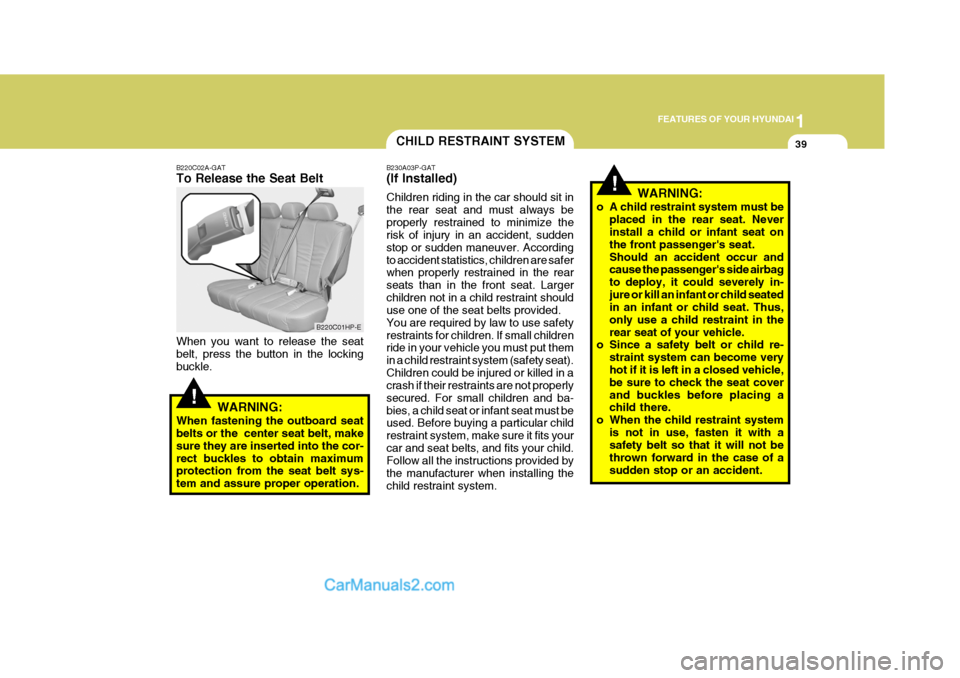
1
FEATURES OF YOUR HYUNDAI
39CHILD RESTRAINT SYSTEM
!
B220C02A-GAT To Release the Seat Belt When you want to release the seat belt, press the button in the locking buckle.
WARNING:
When fastening the outboard seat belts or the center seat belt, make sure they are inserted into the cor-rect buckles to obtain maximum protection from the seat belt sys- tem and assure proper operation. B230A03P-GAT (If Installed) Children riding in the car should sit in the rear seat and must always beproperly restrained to minimize the risk of injury in an accident, sudden stop or sudden maneuver. Accordingto accident statistics, children are safer when properly restrained in the rear seats than in the front seat. Largerchildren not in a child restraint should use one of the seat belts provided. You are required by law to use safetyrestraints for children. If small children ride in your vehicle you must put them in a child restraint system (safety seat).Children could be injured or killed in a crash if their restraints are not properly secured. For small children and ba-bies, a child seat or infant seat must be used. Before buying a particular child restraint system, make sure it fits yourcar and seat belts, and fits your child. Follow all the instructions provided by the manufacturer when installing thechild restraint system.
B220C01HP-E
!WARNING:
o A child restraint system must be placed in the rear seat. Never install a child or infant seat on the front passenger's seat.Should an accident occur and cause the passenger's side airbag to deploy, it could severely in-jure or kill an infant or child seated in an infant or child seat. Thus, only use a child restraint in therear seat of your vehicle.
o Since a safety belt or child re-
straint system can become very hot if it is left in a closed vehicle, be sure to check the seat coverand buckles before placing a child there.
o When the child restraint system is not in use, fasten it with asafety belt so that it will not be thrown forward in the case of asudden stop or an accident.
Page 55 of 539
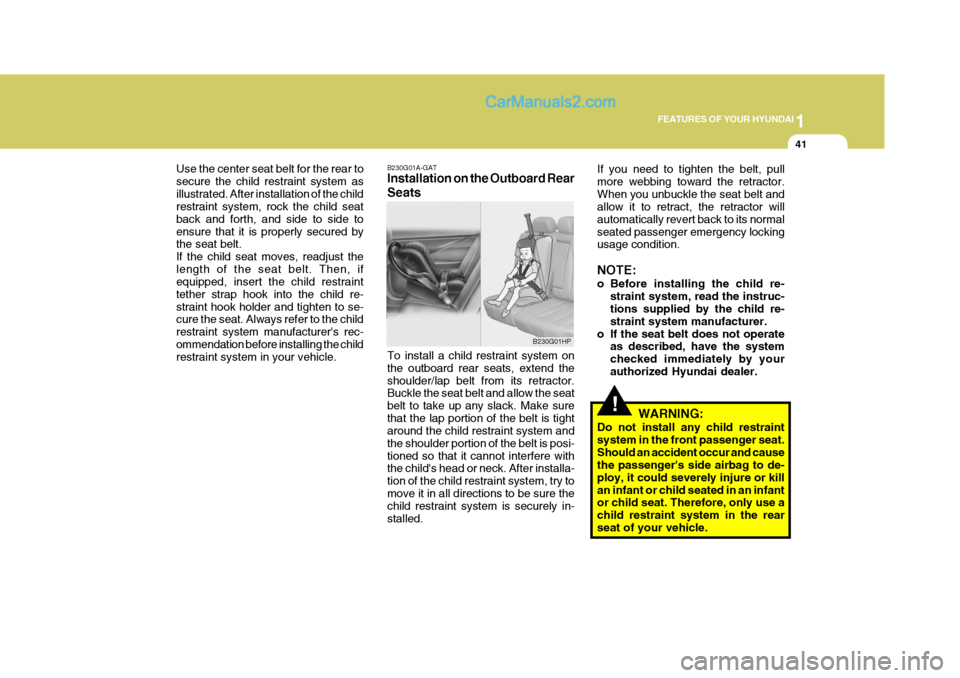
1
FEATURES OF YOUR HYUNDAI
41
!
Use the center seat belt for the rear to secure the child restraint system asillustrated. After installation of the child restraint system, rock the child seat back and forth, and side to side toensure that it is properly secured by the seat belt. If the child seat moves, readjust thelength of the seat belt. Then, if equipped, insert the child restraint tether strap hook into the child re-straint hook holder and tighten to se- cure the seat. Always refer to the child restraint system manufacturer's rec-ommendation before installing the child restraint system in your vehicle. B230G01A-GAT Installation on the Outboard Rear Seats To install a child restraint system on the outboard rear seats, extend theshoulder/lap belt from its retractor. Buckle the seat belt and allow the seat belt to take up any slack. Make surethat the lap portion of the belt is tight around the child restraint system and the shoulder portion of the belt is posi-tioned so that it cannot interfere with the child's head or neck. After installa- tion of the child restraint system, try tomove it in all directions to be sure the child restraint system is securely in- stalled.If you need to tighten the belt, pullmore webbing toward the retractor.When you unbuckle the seat belt and allow it to retract, the retractor will automatically revert back to its normalseated passenger emergency locking usage condition. NOTE:
o Before installing the child re-
straint system, read the instruc- tions supplied by the child re- straint system manufacturer.
o If the seat belt does not operate as described, have the systemchecked immediately by yourauthorized Hyundai dealer.
WARNING:
Do not install any child restraintsystem in the front passenger seat.Should an accident occur and cause the passenger's side airbag to de- ploy, it could severely injure or killan infant or child seated in an infant or child seat. Therefore, only use a child restraint system in the rearseat of your vehicle.
B230G01HP
Page 59 of 539
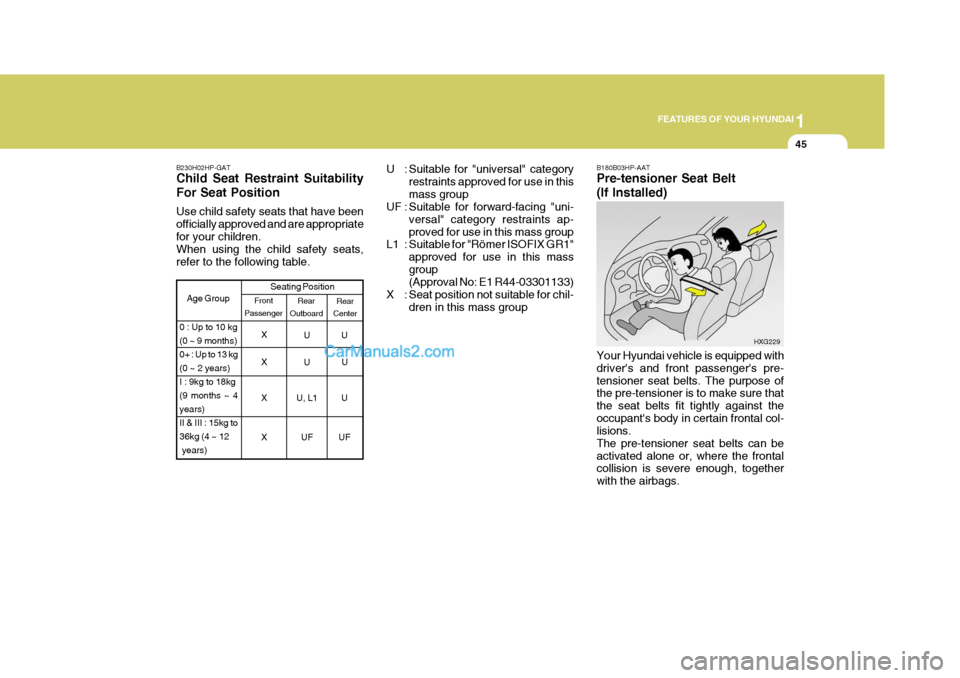
1
FEATURES OF YOUR HYUNDAI
45
B230H02HP-GAT Child Seat Restraint Suitability For Seat Position Use child safety seats that have been officially approved and are appropriatefor your children. When using the child safety seats, refer to the following table.
Rear
Center
Age Group Seating Position
UU
X UU
Rear
Outboard
Front
Passenger
0 : Up to 10 kg (0 ~ 9 months)0+ : Up to 13 kg(0 ~ 2 years)I : 9kg to 18kg(9 months ~ 4years)II & III : 15kg to36kg (4 ~ 12 years) X
X U, L1 U XU
FUF
U : Suitable for "universal" category
restraints approved for use in this mass group
UF : Suitable for forward-facing "uni-
versal" category restraints ap-proved for use in this mass group
L1 : Suitable for "Römer ISOFIX GR1"
approved for use in this massgroup (Approval No: E1 R44-03301133)
X : Seat position not suitable for chil- dren in this mass group B180B03HP-AAT Pre-tensioner Seat Belt (If Installed) Your Hyundai vehicle is equipped with driver's and front passenger's pre-tensioner seat belts. The purpose of the pre-tensioner is to make sure that the seat belts fit tightly against theoccupant's body in certain frontal col- lisions. The pre-tensioner seat belts can beactivated alone or, where the frontal collision is severe enough, together with the airbags.
HXG229
Page 60 of 539
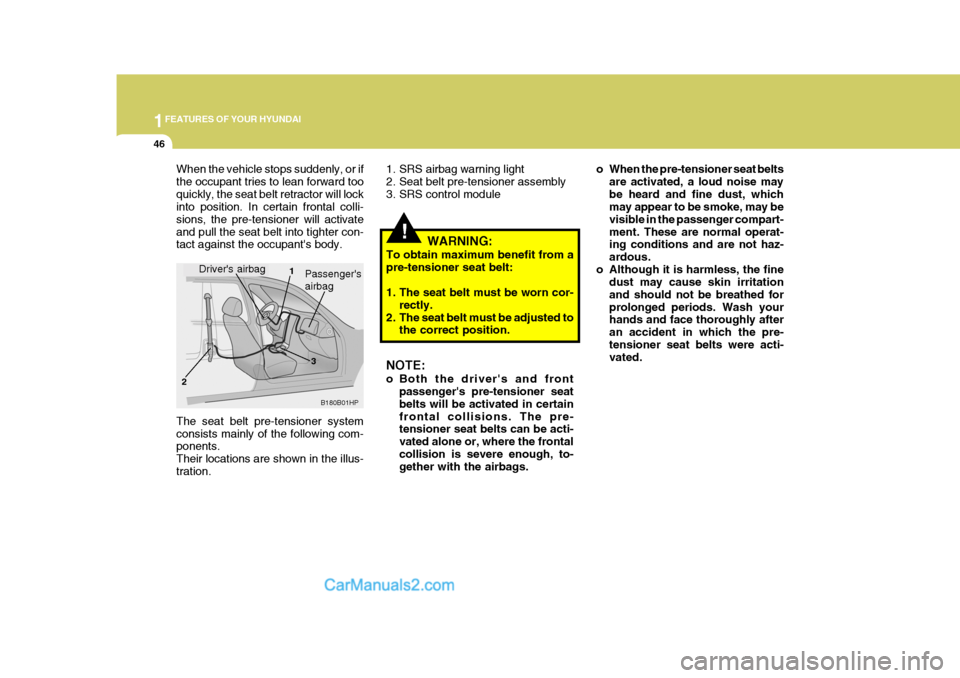
1FEATURES OF YOUR HYUNDAI
46
!
1. SRS airbag warning light
2. Seat belt pre-tensioner assembly
3. SRS control module o When the pre-tensioner seat belts
are activated, a loud noise maybe heard and fine dust, which may appear to be smoke, may be visible in the passenger compart-ment. These are normal operat- ing conditions and are not haz- ardous.
o Although it is harmless, the fine dust may cause skin irritationand should not be breathed forprolonged periods. Wash your hands and face thoroughly after an accident in which the pre-tensioner seat belts were acti- vated.
WARNING:
To obtain maximum benefit from a pre-tensioner seat belt:
1. The seat belt must be worn cor- rectly.
2. The seat belt must be adjusted to the correct position.
NOTE:
o Both the driver's and front passenger's pre-tensioner seat belts will be activated in certainfrontal collisions. The pre- tensioner seat belts can be acti- vated alone or, where the frontalcollision is severe enough, to- gether with the airbags.
When the vehicle stops suddenly, or if the occupant tries to lean forward tooquickly, the seat belt retractor will lock into position. In certain frontal colli- sions, the pre-tensioner will activateand pull the seat belt into tighter con- tact against the occupant's body.
B180B01HP
The seat belt pre-tensioner system consists mainly of the following com- ponents. Their locations are shown in the illus-tration.
Driver's airbag1
2 3Passenger's airbag
Page 61 of 539

1
FEATURES OF YOUR HYUNDAI
47
!WARNING:
o Pre-tensioners are designed to operate only one time. After acti- vation, pre-tensioner seat belts must be replaced. All seat belts,of any type, should always be replaced after they have been worn during a collision.
o The pre-tensioner seat belt as- sembly mechanisms become hotduring activation. Do not touchthe pre-tensioner seat belt as- semblies for several minutes af- ter they have been activated.
o Do not attempt to inspect or re- place the pre-tensioner seat beltsyourself. This must be done byan authorized Hyundai dealer.
o Do not strike the pre-tensioner
seat belt assemblies.
o Do not attempt to service or re- pair the pre-tensioner seat beltsystem in any manner.! CAUTION:
o Because the sensor that activates the SRS airbag is connected with pre-tensioner seat belt, the SRS airbag warning light on the instrument panel will blink for approximately 6 seconds after the ignition key has been turned to the "ON" position or after the engine is started, and then it should turn off.
o If pre-tensioner seat belt is not working properly, this warning light will illuminate even if there is no malfunction of the SRS airbag. If the SRS airbag warning light does not blink for about 6 seconds when the ignition key is turned to "ON" or the engine is started, or if it remains illumi- nated after blinking for approxi- mately 6 seconds, or if it illumi- nates while the vehicle is being driven, please have an authorized Hyundai dealer inspect the pre- tensioner seat belts and SRS airbag system as soon as pos- sible.
AIR
BAG
o Improper handling of the pre-
tensioner seat belt assemblies, and failure to heed the warnings to not strike, modify, inspect, re-place, service or repair the pre- tensioner seat belt assemblies may lead to improper operationor inadvertent activation and se- rious injury.
o Always wear seat belts when driv-
ing or riding in a motor vehicle.
Page 62 of 539

1FEATURES OF YOUR HYUNDAI
48
!
The Hyundai SRS consists of airbags installed under the pad covers in thecenter of the steering wheel and the passenger's side front panel above the glove box. The purpose of the SRSis to provide the vehicle's driver and/or the front passenger with additional pro- tection than that offered by the seat-belt system alone, in case of a frontal impact of sufficient severity. NOTE: Be sure to read information about the SRS on the labels provided on the front of the sun visor and in the glove box. WARNING:
o As its name implies, the SRS is designed to work with, and be supplemental to, the driver's and the passenger's three point seatbelt systems and is not a substi- tute for them. Therefore, your seat belts must be worn at all timeswhile the vehicle is in motion. The airbags deploy only in cer- tain frontal impact conditionssevere enough to likely cause significant injury to the vehicle occupants.
o The SRS is designed to deploy the airbags only when an impactis sufficiently severe and whenthe impact angle is less than 30° from the forward longitudinal axis of the vehicle and will not deployin side, rear or rollover impacts. Additionally, the airbags will only deploy once. Thus, seat beltsmust be worn at all times.
o Front airbags are not intended to
deploy in light collisions in whichprotection can be provided by the seat belt alone.
SUPPLEMENTAL RESTRAINT (AIRBAG) SYSTEM
B240A01HP-AAT (If Installed)
Your Hyundai is equipped with a Supplemental Restraint (Airbag) Sys- tem. The indications of the system'spresence are the letters "SRS AIR BAG" embossed on the airbag pad cover in the steering wheel and thepassenger's side front panel pad above the glove box. Driver's Airbag
B240A01HP
Page 63 of 539
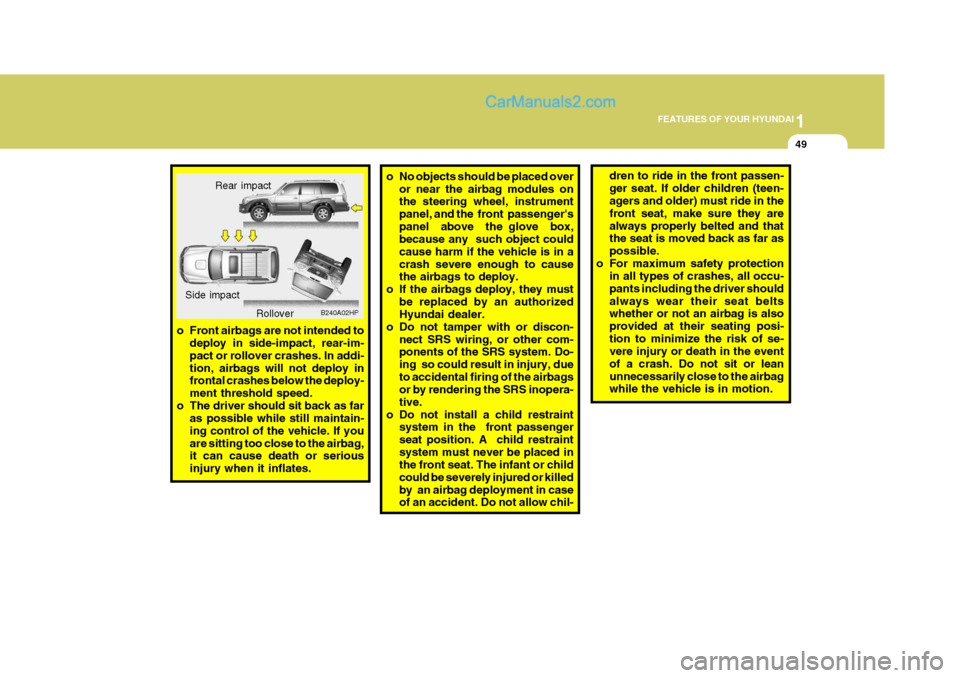
1
FEATURES OF YOUR HYUNDAI
49
o No objects should be placed over
or near the airbag modules on the steering wheel, instrument panel, and the front passenger'spanel above the glove box, because any such object could cause harm if the vehicle is in acrash severe enough to cause the airbags to deploy.
o If the airbags deploy, they must be replaced by an authorizedHyundai dealer.
o Do not tamper with or discon- nect SRS wiring, or other com-ponents of the SRS system. Do- ing so could result in injury, dueto accidental firing of the airbags or by rendering the SRS inopera- tive.
o Do not install a child restraint system in the front passengerseat position. A child restraintsystem must never be placed in the front seat. The infant or child could be severely injured or killedby an airbag deployment in case of an accident. Do not allow chil- dren to ride in the front passen- ger seat. If older children (teen- agers and older) must ride in the front seat, make sure they arealways properly belted and that the seat is moved back as far as possible.
o For maximum safety protection in all types of crashes, all occu-pants including the driver shouldalways wear their seat belts whether or not an airbag is also provided at their seating posi-tion to minimize the risk of se- vere injury or death in the event of a crash. Do not sit or leanunnecessarily close to the airbag while the vehicle is in motion.
o Front airbags are not intended to
deploy in side-impact, rear-im- pact or rollover crashes. In addi-tion, airbags will not deploy in frontal crashes below the deploy- ment threshold speed.
o The driver should sit back as far as possible while still maintain-ing control of the vehicle. If youare sitting too close to the airbag, it can cause death or serious injury when it inflates. Rear impact
B240A02HP
Side impact
Rollover